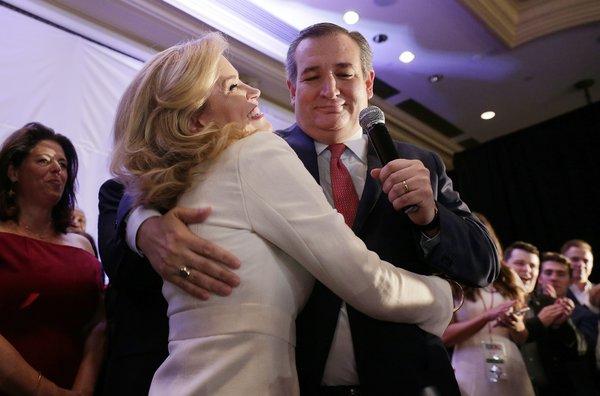Thus does the old political camouflage erode — slowly, but with visible results.
On Tuesday night (and for some, Wednesday morning), as the election results rolled in and candidates gave their victory or concession speeches, the way that many of them chose to present themselves in that moment was as clear a message about how they meant to go on — and the split that was about to become the new normal in Washington — as any of the words they uttered.
Yes, I’m talking about what they wore. Starting next term, Congress is going to have something of a new look, not just because of the striking diversity of race and gender in the House, but because of the new attitude toward image and self-definition that goes with that.
In an era when the president places a premium on “casting” and has raised the stakes on visual communication, and when he put himself and those ideas at the center of the referendum, it’s part of the story.

Senator Ted Cruz hugs his wife, Heidi, after declaring victory at his headquarters in Houston.CreditMichael Wyke/EPA, via Shutterstock
For example, Team Trump — Ted Cruz of Texas, Brian Kemp of Georgia, Ron DeSantis of Florida, to name three — stuck to the party line that kept them in their positions, albeit in down-to-the-wire races, making their appearance in Republican red ties (the kind the president favors, the kind that hark back to the go-go days of Ronald Reagan) with dark suits and white shirts, the effect ironed and buttoned-up and very status quo.
Even more strikingly, as women tipped the House to the Democrats, the promise that had been talked about in so many campaigns — the desire to be themselves, not to don the protective covering of so many who had gone before — was realized. It’s worth noting that for all the talk of a “pink wave,” that color, with all its clichéd associations and sense of cheesy femininity, was barely visible. Instead, there was variety and self-definition.
Alexandria Ocasio-Cortez greets supporters at her election night party.CreditAndrew Kelly/Reuters
In New York, Alexandria Ocasio-Cortez, who became the youngest woman ever elected to Congress, celebrated in a white shirt and beige skirt. Where’s the pantsuit? Fallen by the wayside. She didn’t need it.
There’s a reason her first pair of campaign shoes were worn-out sneakers, which she made a symbol of the shoe not-quite-leather she put into her drive to D.C. Like her red lipstick, the kind that practically went viral when she won her primary and which she sported on Tuesday, they advertised her point of difference. She can have both signifiers.
Sharice Davids with supporters at her election night victory party.CreditWhitney Curtis/Getty Images
In Kansas, Sharice Davids, the first Native American woman elected to Congress from the state, as well as the first openly LGBTQ Kansan and a former mixed martial arts fighter, showed off her muscles in a sleeveless red dress paired with dangling earrings and a brightly patterned scarf. This kind of physical strength has classically been seen as something female candidates should hide. Presumably it’s viewed as potentially threatening to the male voter, an opportunity for opponents to label you “unfeminine.” (Much as Michelle Obama’s arms became a talking point in her husband’s first campaign, viewed with unease by her detractors, and pride by her supporters. And she wasn’t even the candidate.)
But Ms. Davids batted that idea away, making it part of her identity and rejecting that conventional wisdom early on. Indeed, her punching prowess was part of an early campaign video.
So it went. Ayanna Pressley, the first African-American woman to be elected to Congress from Massachusetts, replaced the classic white string of pearls that have generally been the fallback necklace option for female candidates everywhere, the accessory of a white-glove past that in most cases never existed, with her own version of the accessory: a necklace of three big white flowers. She wore her pearls in her ears, and thus both spoke to history and rewrote it. They cast the same light upward, setting off against her black jacket, but they also rejected a received, and perhaps false, convention in favor of a more personal choice.
And Ilhan Omar, the Minnesota Democrat who will be the first Somali-American congresswoman as well as the first woman in a hijab in the House, offered an alternative to ye olde helmet hair. Instead she stood proudly in a ballroom in Minneapolis in a black head wrap with matching dark nails, and a ruched striped jacket, glinting with shine, her hand raised in the air to declare victory.
Ayanna Pressley addresses an election night celebration in Boston.CreditJoseph Prezioso/Agence France-Presse — Getty Images
The move away from the pantsuit, the fake femininity, the pearls, the sprayed-into-submission-bob, may seem like a small thing, given how much else is at stake. To even see it as meaningful in any way may seem ridiculously frivolous. And there are many who still adhere to that old uniform, to be sure, including the senator from New York and possible future presidential candidate, Kirsten Gillibrand, and the Democratic leader Nancy Pelosi.
But in these choices is the beginning of different kind of declaration of independence.










